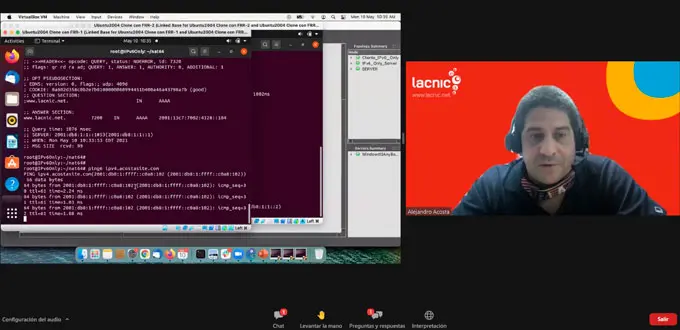LACNIC 35 Online Kicks Off with Two Tutorials
11/05/2021

With nearly 1,200 registered participants, the first day of the LACNIC 35 Online event kicked off with two tutorials —IPv6 Network Operation and Secure Routing— and the LAC Peering Forum.
The IPv6 Network Operation tutorial focused mainly on mechanisms for transitioning to IPv6 and technical aspects for integrating IPv4 and IPv6 prefixes. This tutorial was led by Alejandro Acosta, Uesley Correa, and José Cotúa.
Acosta, R+D Coordinator at LACNIC, observed that the NAT64+DNS64 transition mechanism is a good solution for IPv6-only end devices that need to connect to IPv4-only networks (‘IPv6-Only Client to IPv4-Only Server’).
He pointed out that NAT64 is a transition mechanism specifically designed for IPv6-only clients and solves the problem created when IPv6-only clients wish to establish outgoing connections. Likewise, DNS64 is a translation at the DNS level that acts as a complement to allow IPv6-only clients to always obtain an IPv6 response.
Acosta stressed that IPv4 exhaustion is a good motivation to promote NAT64/DNS64, especially among ISPs.
He admitted that there is a growth of ISP clients and platforms with IPv6, although some applications and portals still do not operate on IPv4. “This means an IPv6-only client and an IPv4-only website,” Acosta explained. NAT64 can be particularly useful for IPv6-only ISP clients and platforms that must connect to IPv4 networks.
José Cotúa then explained the SIIT-DOC transition mechanism and presented some practical demonstrations. He shared the technical details of SITT-DOC and why this mechanism is useful, and then demonstrated its use in IPv6-only datacenters and devices.
(Free access, no subscription required)
During the tutorial on IPv6, Uesley Correa addressed the use of 464xlat as an IPv4 to IPv6 transition mechanism. After showing some examples (see video), Correa asked ISPs not to purchase anything that does not support IPv6, as that would be equivalent to “purchasing junk.”
Secure Routing. Guillermo Cicileo and Erika Vega closed the day with their tutorial on secure routing. In his presentation, Cicileo stressed that the total number of routing security incidents (leaks + hijacks) has decreased by 8% over the past year, with statistics showing a significant fall in route leaks. “A larger number of organizations have implemented measures to improve routing security,” noted Cicileo. However, he stressed that a higher number of route hijacks had been reported. The tutorial then presented some exercises on how to improve routing security.
Security Incidents
